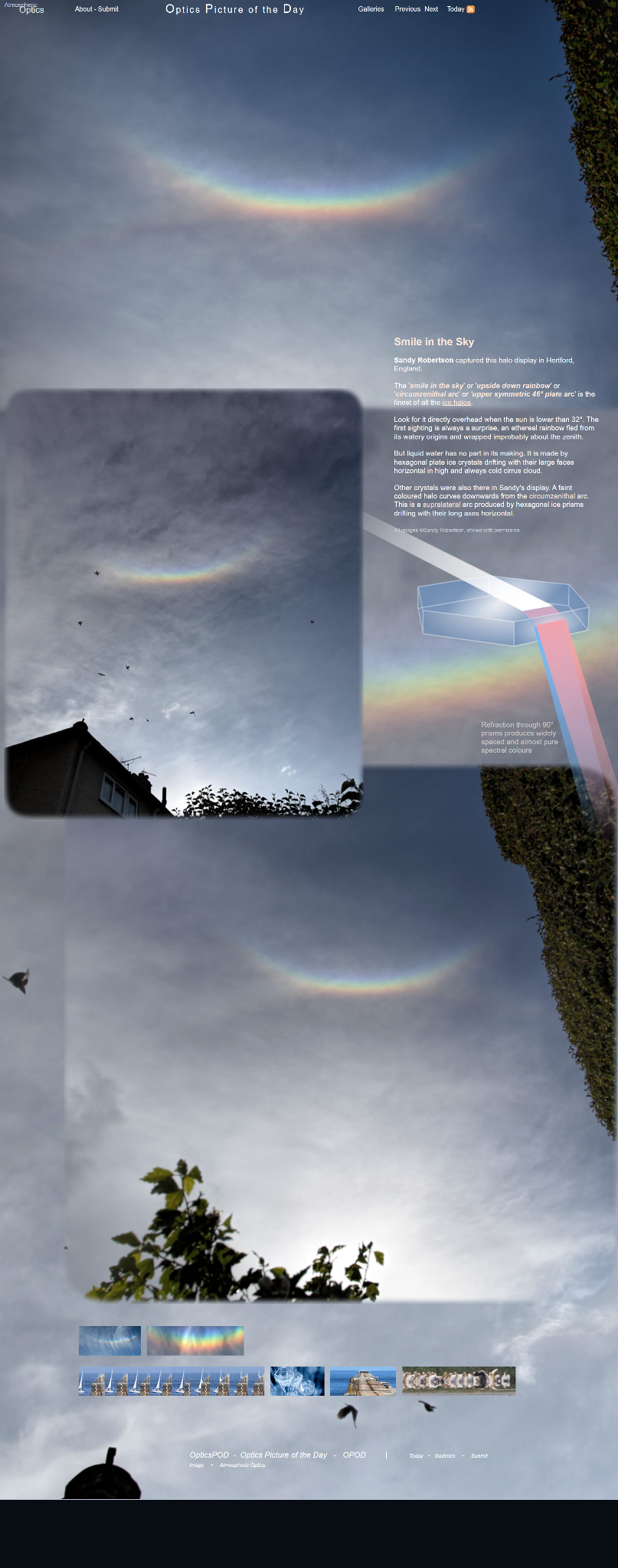Circumzenithal and supralateral arcs - OPOD
Circumzenithal and Supralateral Arcs - OPOD: A Spectacular Display of Atmospheric Optics
Have you ever looked up at the sky and been captivated by a mesmerizing sight that resembles an upside-down rainbow? If so, you may have witnessed the remarkable phenomenon known as the "smile in the sky" or the "circumzenithal arc." This ethereal display, also referred to as the "upper symmetric 46° plate arc," is considered the most exquisite of all ice halos.
Unlike a traditional rainbow, which is created by the interaction of sunlight with raindrops, the circumzenithal arc is formed by hexagonal plate ice crystals. These crystals align themselves horizontally within high-altitude cirrus clouds, which are always cold. When the sun is positioned lower than 32°, this celestial spectacle can be observed directly overhead, appearing unexpectedly and captivating all who witness it.
While the circumzenithal arc steals the show, it is not the only optical phenomenon at play. Another intriguing feature often accompanies this display - the supralateral arc. This faintly colored halo curves downward from the circumzenithal arc and is produced by hexagonal ice prisms drifting with their long axes positioned horizontally. Together, these two arcs create a breathtaking visual spectacle that leaves observers in awe.
The formation of these arcs can be attributed to the process of refraction. As sunlight passes through the hexagonal ice crystals, it undergoes a bending effect known as refraction. The 90° angle of these ice prisms causes the refraction to produce widely spaced and almost pure spectral colors. This results in a vibrant display of hues that adds to the enchantment of the circumzenithal and supralateral arcs.
To fully appreciate the beauty of these atmospheric optics phenomena, it is essential to understand their scientific origins. The hexagonal ice crystals responsible for creating these arcs are formed within cirrus clouds, which consist of ice particles rather than water droplets. These clouds are found at high altitudes where temperatures are consistently low, allowing the ice crystals to maintain their unique structure.
The alignment of the hexagonal ice crystals is crucial in producing the circumzenithal and supralateral arcs. As they drift within the cirrus clouds, their large faces and long axes remain horizontal. This specific orientation enables the sunlight to interact with the crystals in a way that generates the stunning visual effects observed in the sky.
Witnessing the circumzenithal and supralateral arcs is a rare occurrence that requires specific atmospheric conditions. Therefore, it is truly a special moment when one is fortunate enough to catch a glimpse of these extraordinary optical displays. The surprise and awe experienced when encountering the "smile in the sky" serve as a reminder of the wonders that can be found within our natural world.
In conclusion, the circumzenithal and supralateral arcs offer a glimpse into the captivating world of atmospheric optics. These ethereal displays, created by hexagonal ice crystals within cirrus clouds, provide a breathtaking visual spectacle that leaves observers in awe. While the circumzenithal arc steals the show with its vibrant colors and position directly overhead, the supralateral arc adds an extra touch of magic to the overall display. Witnessing these phenomena is a rare and unforgettable experience that reminds us of the beauty and complexity of our atmosphere. So, next time you find yourself gazing at the sky, keep an eye out for the "smile in the sky" - you never know when nature's enchanting display will grace your presence.

Smile in the Sky
Sandy Robertson captured this halo display in Hertford, England.
The 'smile in the sky' or 'upside down rainbow' or 'circumzenithal arc' or 'upper symmetric 46° plate arc' is the finest of all the ice halos.
Look for it directly overhead when the sun is lower than 32°. The first sighting is always a surprise, an ethereal rainbow fled from its watery origins and wrapped improbably about the zenith.
But liquid water has no part in its making. It is made by hexagonal plate ice crystals drifting with their large faces horizontal in high and always cold cirrus cloud.
Other crystals were also there in Sandy's display. A faint coloured halo curves downwards from the circumzenithal arc. This is a supralateral arc produced by hexagonal ice prisms drifting with their long axes horizontal.
All images ©Sandy Robertson, shown with permission
Refraction through 90° prisms produces widely spaced and almost pure spectral colours
Note: this article has been automatically converted from the old site and may not appear as intended. You can find the original article here.
Reference Atmospheric Optics
If you use any of the definitions, information, or data presented on Atmospheric Optics, please copy the link or reference below to properly credit us as the reference source. Thank you!
-
<a href="https://atoptics.co.uk/blog/circumzenithal-and-supralateral-arcs-opod/">Circumzenithal and supralateral arcs - OPOD</a>
-
"Circumzenithal and supralateral arcs - OPOD". Atmospheric Optics. Accessed on April 18, 2024. https://atoptics.co.uk/blog/circumzenithal-and-supralateral-arcs-opod/.
-
"Circumzenithal and supralateral arcs - OPOD". Atmospheric Optics, https://atoptics.co.uk/blog/circumzenithal-and-supralateral-arcs-opod/. Accessed 18 April, 2024
-
Circumzenithal and supralateral arcs - OPOD. Atmospheric Optics. Retrieved from https://atoptics.co.uk/blog/circumzenithal-and-supralateral-arcs-opod/.